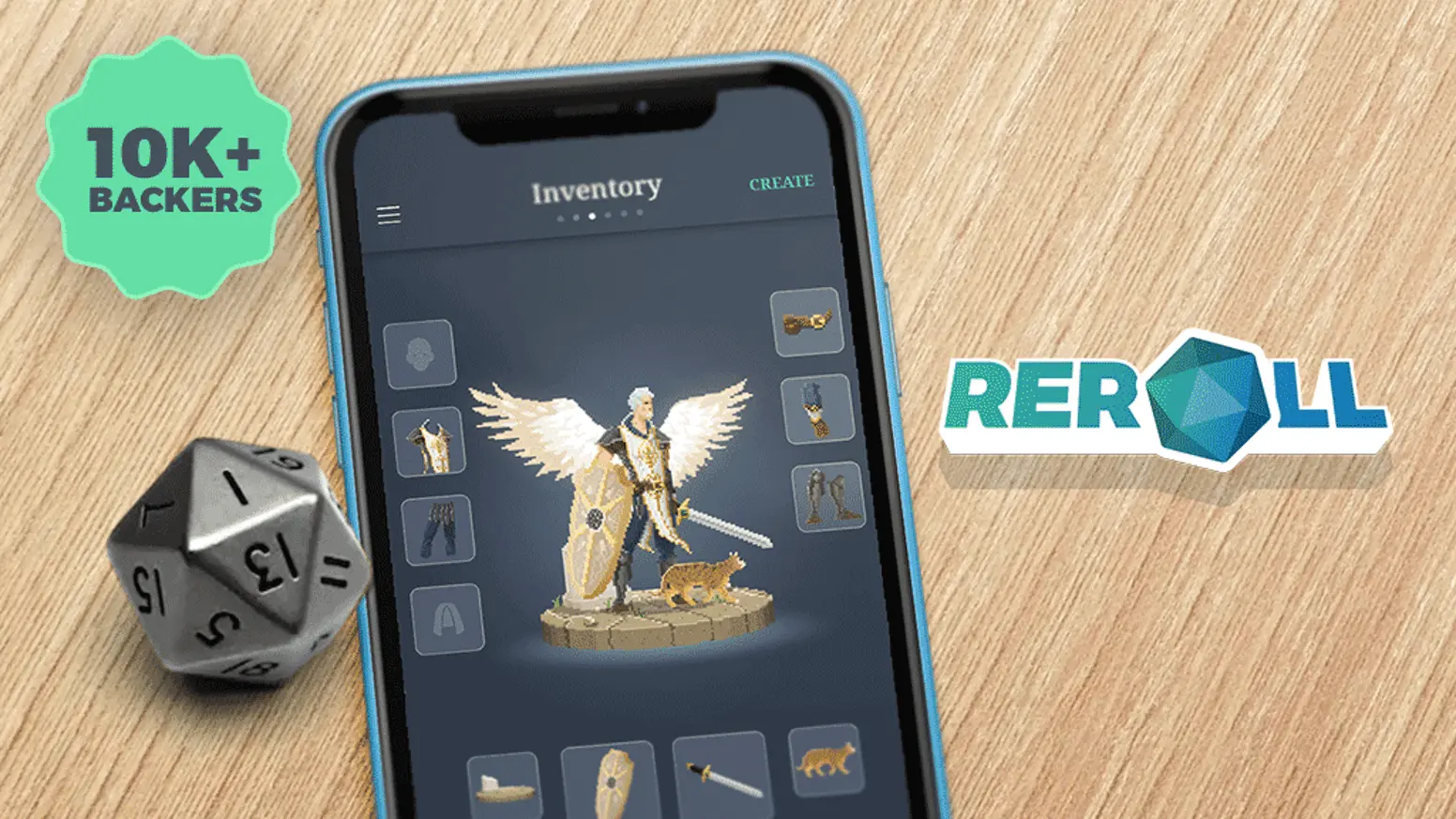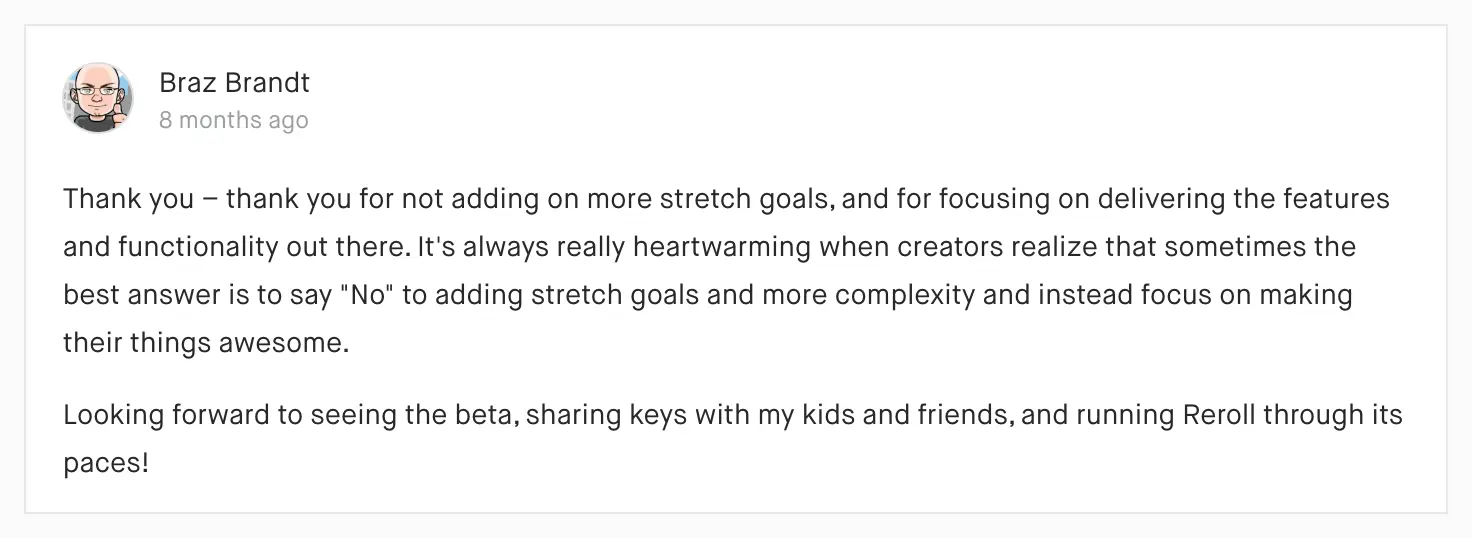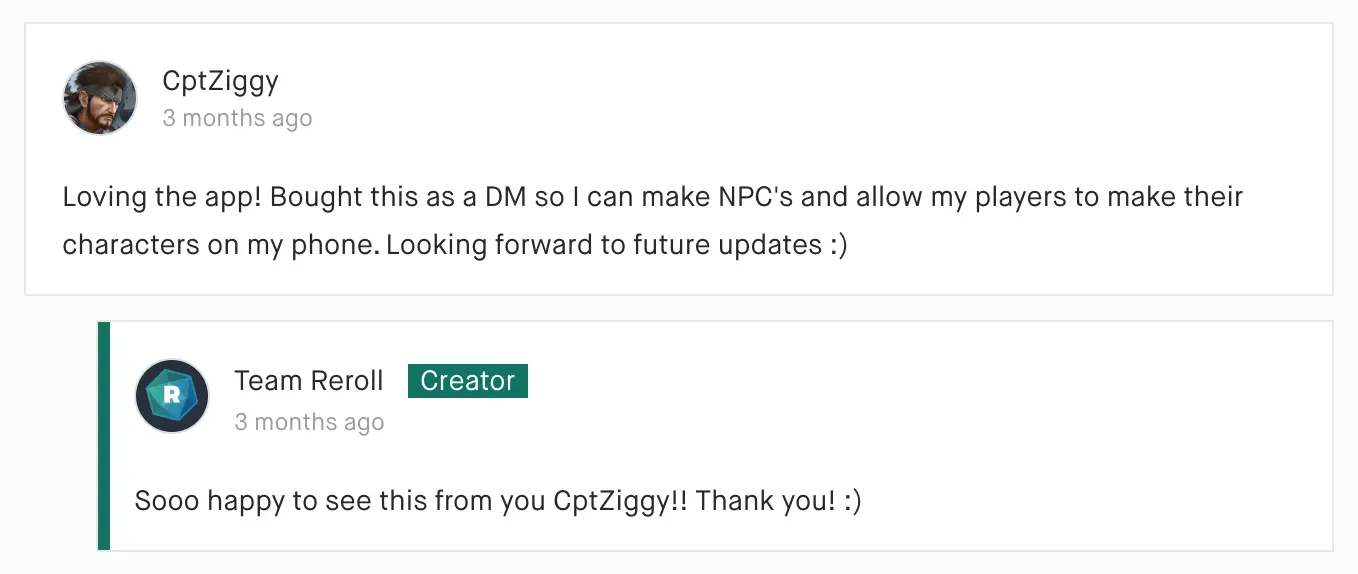Jan 24, 2020
Reroll - a notebook for D&D character stats. Our experience of launching on Kickstarter and raising $20K in 8 hours

Story about how an unknown hobby can evolve into an idea for a full-fledged project, how this project can be launched on Kickstarter with minimal investment, and what can come out of all this.
What is the project?
Reroll - an application for storing Dungeons & Dragons (D&D) character stats and generating their pixel art-style appearance.
Where did the idea come from?
One day, after playing basketball and discussing hobbies and projects, our designer (Danny) mentioned that he and his wife enjoy playing Dungeons & Dragons (D&D). While we had heard of D&D, none of us were involved in it and we couldn't believe that people still played it. It turned out that the game was gaining popularity, and it still had fans.
Dungeons & Dragons (D&D) is a tabletop role-playing game in the fantasy genre. The game involves a Dungeon Master (DM) and players. The DM is the storyteller and judge. They don't have their own character; their task is to narrate the story, describe the game world/events, and ensure that everything follows the rules. Each player typically represents a single character in the game who undergoes various challenges.The essence of the game is to overcome adventures and level up their characters.The game relies heavily on participants' imagination: the DM describes the plot, and players verbalize their actions and roll dice to determine the success or failure of their actions.
All D&D characters have a set of stats that change throughout the game. Therefore, every D&D player uses something to record and update these stats.
Danny had the idea to create an application where each player could record their character's stats and also create/visualize their appearance in pixel art style.
There are already plenty of apps for editing character stats, so the main highlight of the project had to be the generation of the hero's appearance in pixel art style.
And that's how the idea was born to create an application for recording D&D character stats and creating their appearance.
Why Pixel Art?
First of all, it's something that our friend and his wife love. They enjoy coming up with and drawing characters for the game, including their weapons, armor, and other attributes like pets.
Secondly, it's something that many D&D players have a warm feeling towards, probably due to nostalgic memories of the 90s when all graphics were in the pixel art style.
Is It Worth It?
We were skeptical about the project idea. None of us played D&D, and we had no idea if there would be demand for another app of this kind (there are already existing alternatives). Nobody wanted to waste time on a "development in vain" project. However, Danny provided interesting data. About a year ago, he tried to test the demand for this idea by creating a simple landing page and conducting a survey in several D&D communities. As a result, he gathered around 1000 email subscriptions from those who found it interesting and were willing to pay around $10 for a subscription. Danny even attempted to start developing this app, but his developer acquaintances couldn't bring it to a functional state.
In the end, we have the app design, a set of pixel art assets (images used to create characters), and around 1000 subscriptions (potential customers). In a successful scenario, our app could generate around $10K. So, the decision was made - let's give it a try!
How Will We Do It?
From the very beginning, we decided to limit the resources we could invest in developing the demo (MVP) of this app: no more than one month of work for two developers (approximately 320 hours).
How Will We Promote and Sell?
While we were working on the demo, the idea's creator actively brainstormed ways to launch and promote the app. The problem was that even with a subscriber base of around 1000, we hadn't made any sales yet. We didn't want to create a fully working version of the app right away, as it would require more than a month. Therefore, our plan was to create a demo version, gather paid pre-orders, and only then develop a full working version.
There were two options for organizing pre-order collection:
- Creating our own landing page with payment integration.
- Using Kickstarter.
The advantage of having our own landing page is that there wouldn't be any additional fees.
The advantage of Kickstarter is trust - users would be more willing to "purchase" on the platform compared to an unknown landing page. Therefore, we decided to use Kickstarter.
Kickstarter Launch
By the time we launched on Kickstarter, we already had a working demo. Danny created a mini-video presentation of the app, wrote texts, prepared all the necessary images, and also designed various "rewards" and "stretch goals" for the campaign (meaning that upon reaching a certain funding milestone, we would add additional features).
We set the funding goal at $10K for 40 days. This amount would cover all development expenses and allow Danny to focus on creating art for the app (designing new skins).
On April 9, 2019, the project was published on Kickstarter, and at the same time, Danny posted about it on Reddit. From that point on, all we had to do was wait.
Kickstarter Campaign
Unexpectedly, after just 8 hours since the launch, we had already raised $20K.
The Reddit post went viral, skyrocketed to the top, and attracted a huge number of D&D fans. Their feedback was very positive, and everyone loved the idea of visualizing characters in pixel art style. They all became backers of our project!
But we didn't stop at just one Reddit post. In parallel, Danny wrote press releases and sent them to various relevant media outlets. Each publication brought us new audiences and backers. Additionally, we ran Facebook ads (fortunately, we had a good marketing department). We also took advantage of a Kickstarter promotion agency's mailing list. In the past, Kickstarter didn't hide backers' emails, so some active users managed to scrape the backers' database and now use it for their own "top projects" mailing list, taking a 25% fee.
After about 35 days, we reached all the "stretch goals" and secured the top position among ongoing projects on Kickstarter. Once that happened, the number of backers and the total amount raised skyrocketed rapidly. We had about 5 days left and needed to make a decision:
- Add more "stretch goals," extend the campaign duration, and try to raise even more funds.
- Stick with what we had achieved, informing users that any additional funds would go towards further improving the app.
We chose the second option, and it turned out to be the right decision. Users appreciated that we didn't get greedy and genuinely wanted to deliver a great product.

The campaign concluded, and we exceeded the initial funding goal by a significant margin. We gained around 50K users from 18,768 backers (one backer could purchase access for multiple users). Everyone is satisfied, and we continue the development of the project, as there is still a lot we need to accomplish.
The Kickstarter campaign was incredibly exciting - witnessing the number of backers grow before our eyes, receiving positive comments from users - it all serves as great motivation to work harder and better!

Withdrawal of Payments from Kickstarter
About 10% of payments did not go through because banks blocked the transactions suspecting them of fraud. Kickstarter stated that this was a common practice and they couldn't do anything about it.
We had to quickly set up a landing page with payment acceptance so that backers whose payments didn't go through Kickstarter could pay on our website and receive all the early adopter privileges.
Credits
Credit must be given to Danny. Without him, this project would not have been possible. He did an incredible job: engaging with the community on Reddit and Kickstarter (he responded to almost every comment, which numbered in the hundreds), preparing all the materials, and working with partners.
In addition to Danny, huge respect goes to our developers. They put in a lot of work, both in development and optimizing this and other applications we have.
And of course, a big shoutout to the entire D&D community that supported the project. Without them, nothing would have been possible. Launching any project is a team effort (including the community), and every member of this team is crucial!
This is one of the most interesting projects I've had the opportunity to be a part of.
Conclusions
Disclaimer: These conclusions are extremely obvious and have been "repeatedly repeated" many times. This is more of a summary for myself so that I don't forget.
1. Don't rely on your own feelings about the "worthiness" or "unworthiness" of an idea
Especially if you're not an expert in that field. But even if you are an expert, your assessment can also be "distorted" due to professional experience.
2. Always validate ideas and hypotheses before starting development
This advice may seem obvious, but it's something you need to constantly remind yourself of to avoid diving into development just for the sake of development.
3. Limit the feature set for the demo/MVP
There's always a strong temptation to add this or that "essential thing" to the project that will make the demo more impressive. To avoid getting lost in development for the sake of development, you need to limit the task list for the MVP.
4. Set clear deadlines and constraints
If it's a commercial project, there should always be strict deadlines and cost limitations. Otherwise, it's very easy to go beyond the scope and "sink" the project by going into negative financials.
5. Engage with the community
The audience is the most important part of any project. The ability to work with them is a key factor for success. It's important to actively respond to customer feedback, be honest with them, provide timely updates on changes, and promptly address their questions, especially in the early stages.
What Happened Next?
Next comes the interesting path of developing and launching the application, including alpha and beta releases. It may seem standard, but there were nuances, failures, and successes. If you're interested, I can provide more details in another article.
originally posted on vc.ru